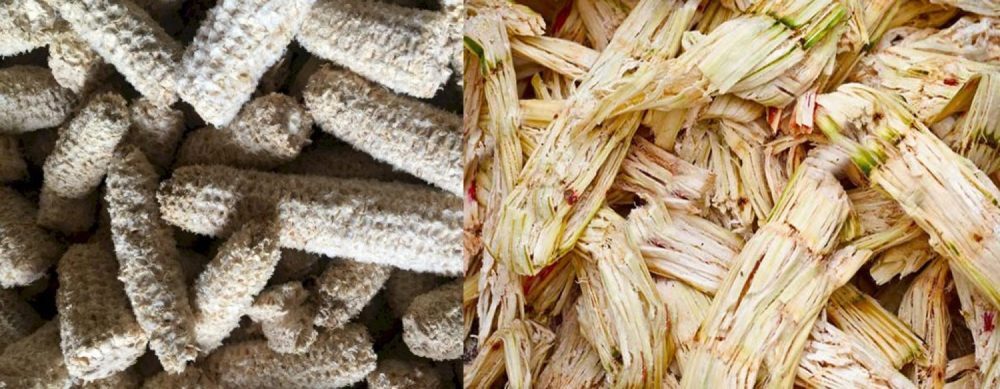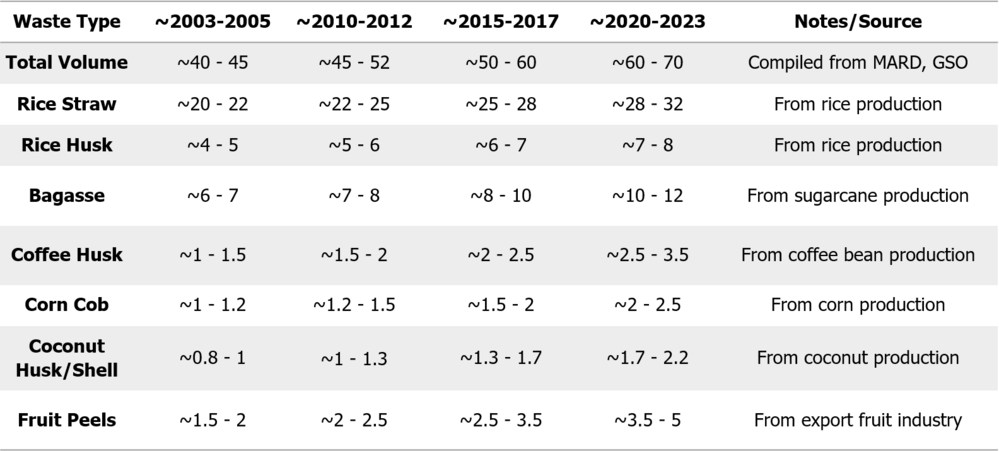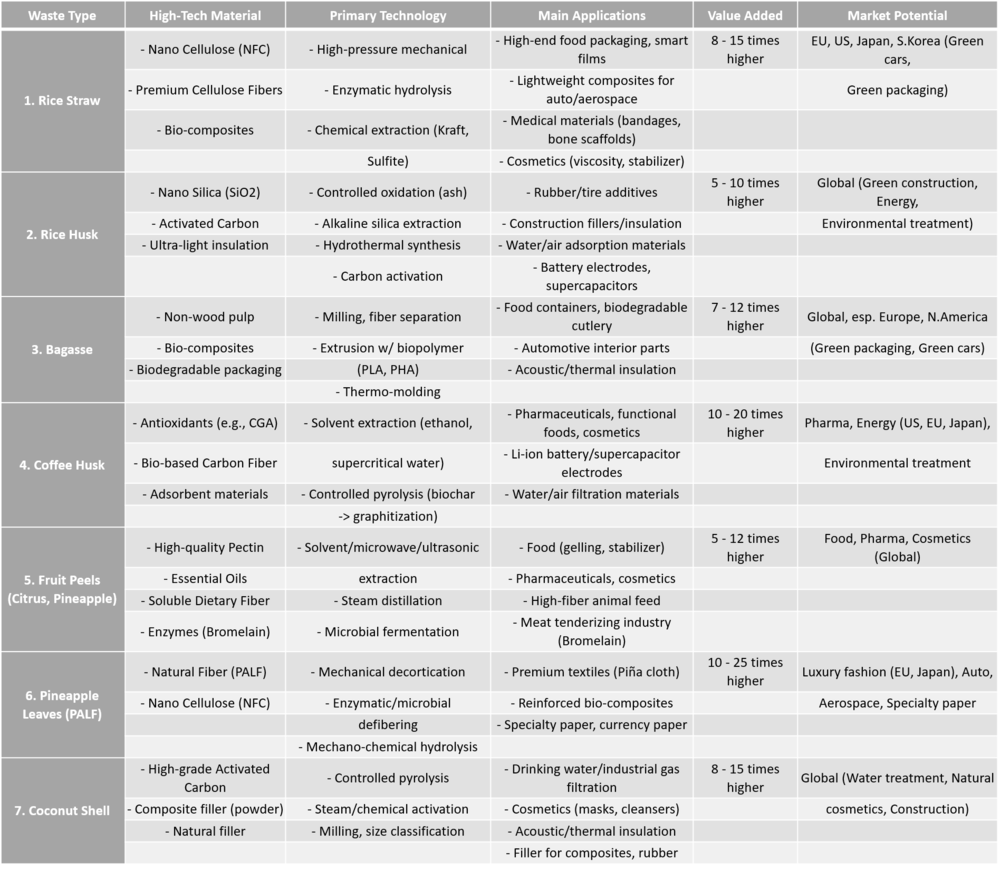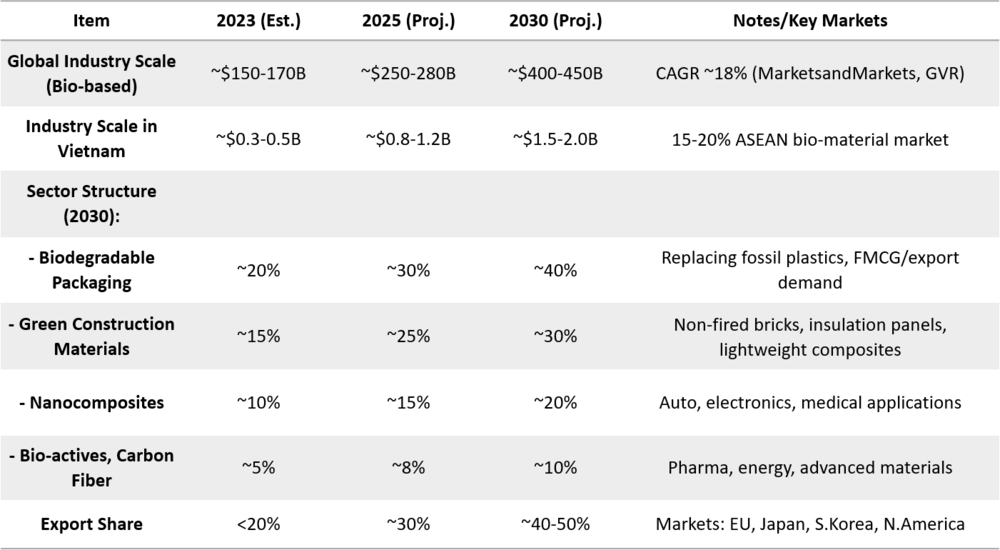Beneath the golden sun stretching over endless rice fields, the coffee-laden slopes of the Central Highlands, or the lush coastal pineapple and coconut groves, lies a forgotten source of "gold": agricultural waste. Vietnam discards 60-70 million tons of this annually, most of which is burned or buried, causing severe pollution. However, modern science and technology are transforming this "waste" into the foundation of a billion-dollar industry: high-tech material production. This represents not only a major economic opportunity—projected to reach $1.5 - $2 billion USD by 2030 (Ministry of Agriculture and Rural Development - MARD)—but also the key to building a sustainable circular agriculture system.

Figure 1. Vietnam's diverse and rich source of agricultural products
Foundation: Massive Raw Material Sources and Policy Direction
The past two decades (2003-2023) have witnessed stable growth in Vietnam's agriculture, leading to a corresponding increase in waste. Rice, corn, coffee, and sugarcane output maintains a growth rate of 2-4% per year. This means an increasingly abundant and stable supply of raw materials for the new materials industry. However, the current paradox is that the recycling/utilization rate of this waste remains below 50%. Most rice straw is burned after harvest; bagasse and rice husks are only partially used for simple purposes like fuel; the rest remains an environmental burden.
Table 1: Estimated Output of Major Agricultural Waste in Vietnam (2003-2023) (Unit: Million tons/year)*

*Ministry of Agriculture and Rural Development (MARD), General Statistics Office (GSO) - Annual Report - 2023* [1]
Policy direction is creating strong momentum for this transformation. The Government's Green Growth Strategy for 2021-2030 prioritizes the circular economy. The Scheme for New Material Development towards 2030 (issued 2020) specifically focuses on researching, producing, and applying bio-based materials and nanocomposites – precisely the most promising products from agricultural waste streams. Policies offering tax incentives and funding support for green tech R&D are being implemented, creating a favorable environment for business investment [2].
From Waste to High-Tech Materials: Technology, Applications, and Massive Added Value
The miracle lies in how high technology can transform raw waste into valuable materials, generating value many times higher than crude use or disposal. Below is a detailed analysis of 7 key waste types, including those requested (fruit peels, rice straw, pineapple leaves, cattail leaves, coconut shells) and two highly potential additions (coffee husks, bagasse):
Table 2: Technology, Applications, and Added Value of Materials from Waste

Table 3: Projected Economic Scale for Vietnam's High-Tech Material Industry from Agricultural Waste [3]:

Realizing Potential: Advantages and Challenges for Circular Agriculture
Vietnam possesses "golden" advantages to develop this billion-dollar industry:
- Abundant, renewable raw materials: As Table 1 shows, massive and growing waste volumes provide a solid foundation. Input costs are low, and materials regenerate annually with agricultural cycles.
- Strengthening supportive policies: The Green Growth Strategy, New Materials Scheme, and tax/land/loan incentives for green projects create a favorable legal framework.
- Booming global market demand: ESG trends and Net Zero commitments are driving global demand for sustainable, biodegradable materials. Vietnam has a competitive edge due to cheap, abundant raw material supply.
However, realizing this potential faces significant challenges, especially in building efficient circular agriculture:
- Limited deep-processing technology: This is the biggest barrier. Refining technologies like nano-silica extraction, nano-cellulose production, nanocomposite synthesis, and controlled pyrolysis for carbon fiber require high expertise and major investment. Lack of integrated collection, sorting, and pre-processing systems at source leads to high transport costs and lower input quality.
- Massive investment capital: Building a high-tech material plant (e.g., bio-composite, nano cellulose) requires $20 - 50 million USD or more, plus ongoing R&D costs. Accessing long-term capital at reasonable rates remains difficult, especially for domestic private firms [4].
- Fragmented value chain: Weak linkages between the "three pillars": Farmers (stable, quality raw material supply) - Businesses (processing, markets) - Research Institutes/Universities (technology, training). This leads to unstable supply, mismatched technology, and products failing international standards.
- Collection infrastructure & logistics: Collecting dispersed agricultural waste (e.g., rice straw, PALF) is fragmented and costly. Lack of local collection/pre-processing centers makes transporting bulky materials a burden [5].
- Standards & output markets: Clear national standards for recycled and bio-based materials are needed to ensure quality and build market trust. Meeting strict international standards (EU, US, Japan) is also a major challenge.
Conclusion: Turning "Waste" into "Gold" - The Essential Path to a Green Future
Vietnam's massive agricultural waste is no longer just an environmental burden; it is becoming a "gold mine" for the billion-dollar high-tech materials industry. With a projected scale of $1.5 - 2 billion USD by 2030, this sector offers not only superior economic returns, many times the original waste value, but also a fundamental solution to rural pollution and a powerful driver for the circular agriculture model [6,7].
Rice straw becomes valuable nano-cellulose for medicine; rice husks transform into nano-silica for electronics; bagasse, pineapple leaves, and coconut shells turn into bio-composites for green cars and biodegradable packaging; coffee husks and fruit peels become sources of pharmaceutical actives and carbon fiber... – this is the power of science and technology in the circular economy.
To realize this potential and make Vietnam the ASEAN hub for green materials from agricultural waste, a comprehensive, synchronized strategy is needed: Technology breakthrough (prioritize R&D, transfer advanced tech, especially from Japan/EU); Policy refinement (standards, specific tax/capital incentives, promote green public procurement); Building resilient linkages (apply IoT in collection, establish bio-industrial clusters near material sources); and Strongly attracting FDI into green high-tech materials. Only then can the flow of "waste - resource - advanced material - global market" operate smoothly, turning resource advantages into real economic strength, for a sustainable and high-value Vietnamese agriculture.
References
- [1]. *Statistical Report on Vietnam's Agricultural Waste (2003-2023)* - Ministry of Agriculture and Rural Development (MARD), General Statistics Office (GSO) - Annual Report - 2023
- [2]. Scheme for New Material Development towards 2030 - Government of Vietnam - Resolution No. 164/NQ-CP -- 2020
- [3]. *National Green Growth Strategy for 2021-2030* - Government of Vietnam - Decision No. 1658/QD-TTg - 2021
- [4]. Bharimalla, A. K., Deshmukh, S. P., Patil, P. G., & Vigneshwaran, M. (2017). Nano Cellulose: From Biomass Sources to Industrial Applications. Advanced Materials Letters, 5(2). Elsevier.
- [5]. Nguyen, V. H., Le, T. H. Y., & Tran, Q. T. (2020). Nano Silica from Rice Husk Ash: Extraction Technology and Applications. Journal of Materials Science and Technology, 28(4). Springer.
- [6]. *Global Bio-based Materials Market Report 2023-2030* - Grand View Research, MarketsandMarkets - Market Research Report - 2023
- [7]. Ramesh, M., Rajeshkumar, L., & Deepa, C. (2022). Bio-composites Reinforced with Natural Fibers: Applications in Automotive and Construction. Renewable Materials Journal, 15(3). Elsevier.
Dr. Doan Van Thuan